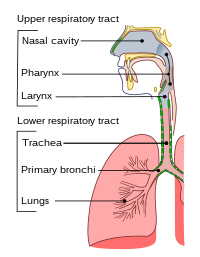
Photo from wikipedia
Abstract Background Endoluminal tracheal stenting can relieve signs associated with tracheal collapse syndrome (TCS) in dogs, but major complications can result. Objective To identify associations among tracheal dimensions, stent dimensions,… Click to show full abstract
Abstract Background Endoluminal tracheal stenting can relieve signs associated with tracheal collapse syndrome (TCS) in dogs, but major complications can result. Objective To identify associations among tracheal dimensions, stent dimensions, and subsequent complications requiring additional stent placement after endoluminal stenting for TCS. Animals Fifty‐two dogs from the hospital population. Methods Medical records of dogs that received an endoluminal self‐expanding tracheal stent for TCS by the interventional radiology service between 2009 and 2014 were reviewed for relevant data. Signalment and clinical details, including tracheal collapse type, tracheal measurements, nominal stent dimensions, follow‐up evaluation times, and stent complications, were recorded. Results Fifty‐two dogs that received an endoluminal stent for TCS met the inclusion criteria. Major complications included stent fracture (13/52; 25%), obstructive tissue ingrowth (10/52; 19%), and progressive tracheal collapse (6/52; 12%). Natural tracheal taper (P = .04) and more stent diameter oversizing (P = .04) in the intrathoracic (IT) trachea were associated with caudodorsal stent fracture. Only stents with a 14‐mm nominal diameter fractured. Progressive tracheal collapse was associated with smaller maximum tracheal diameters (P = .02). The majority of dogs with obstructive tissue ingrowth (7/10; 70%; P = .30) and all dogs with thoracic inlet fractures (3/3; 100%) had tracheal malformations. Conclusions and Clinical Importance A higher taper in tracheal diameter may lead to increased risk of fracture in the IT location. Dogs with tracheal malformations may have higher risk for thoracic inlet fracture and development of obstructive tissue ingrowth. Clinicians should be aware of the possible risk factors for tracheal stent complications.
Journal Title: Journal of Veterinary Internal Medicine
Year Published: 2019
Link to full text (if available)
Share on Social Media: Sign Up to like & get
recommendations!